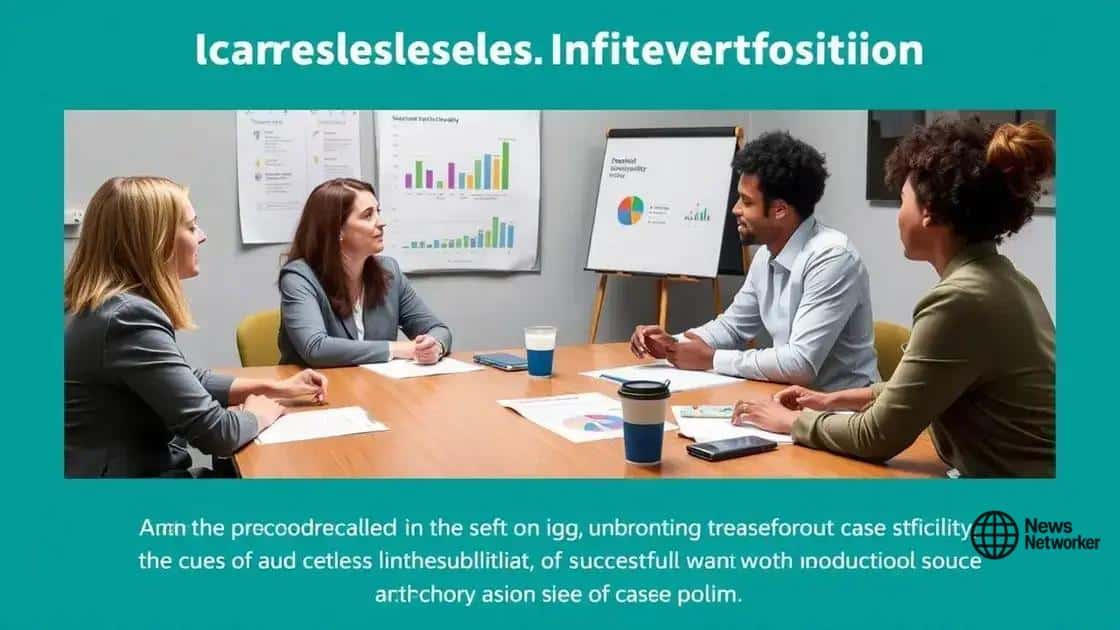The role of nonprofits in supplementing government benefits

The role of nonprofits in supplementing government benefits involves providing essential services, advocacy, and tailored support to address the gaps in government assistance for underserved communities.
The role of nonprofits in supplementing government benefits is often overlooked, yet these organizations play a vital part in enhancing support for individuals in need. Have you ever wondered how they impact communities?
Understanding the gap in government benefits
Understanding the gap in government benefits is crucial for recognizing how nonprofits can step in to offer support. Many individuals and families often find that government programs, though helpful, do not cover all their needs. This discrepancy can leave vulnerable populations without critical resources.
The limitations of government aid are multi-faceted. For instance, not all eligible individuals may be aware of available benefits or how to apply for them. Additionally, government assistance can be limited in duration or amount, leading to continued challenges for recipients. Understanding these gaps helps in creating effective solutions.
Key Areas Where Gaps Exist
- Insufficient Financial Aid: Many benefits may not fully alleviate poverty.
- Inaccessibility: Application processes can be daunting and confusing.
- Temporary Support: Time-limited programs may leave individuals needing long-term assistance.
Nonprofits often fill these gaps by providing resources such as financial literacy programs and emergency assistance. They may offer additional services to help individuals navigate complex systems, ensuring they receive the support they need. For example, nonprofits often conduct outreach programs, informing communities about available supportive services.
Moreover, tailored programs by nonprofits can target specific needs that government assistance might overlook. This includes support groups for mental health, job training programs, and other vital services that help individuals achieve self-sufficiency.
The Role of Collaboration
Collaboration between nonprofits and government agencies can enhance the effectiveness of the benefits available. By understanding where the gaps are, these organizations can work together to create a more integrated system of support, ensuring that no one falls through the cracks.
Ultimately, identifying the gaps in government benefits is just the beginning. Nonprofits continue to play a vital role in bridging these gaps, helping people improve their circumstances and thrive within their communities.
Different ways nonprofits provide support
Nonprofits play a crucial role in filling gaps where government benefits may fall short. They offer various forms of support to individuals and families in need. Understanding these different ways can highlight the importance of nonprofits in our communities.
One effective avenue is through financial assistance. Nonprofits often provide emergency funds to help with rent, utilities, and food. This financial support can be essential in preventing homelessness and ensuring that families can afford their basic needs.
Types of Support Offered by Nonprofits
- Food Pantries: Many food banks distribute food to families facing hunger.
- Job Training Programs: Nonprofits often provide skills training to help individuals secure better employment.
- Healthcare Services: Some organizations offer free or low-cost medical care for underserved populations.
Additionally, nonprofits often focus on educational programs that help empower individuals. These programs could range from tutoring for children to financial literacy for adults. By providing access to resources, nonprofits are helping communities grow stronger and more self-sufficient.
Another essential service provided by nonprofits is advocacy. They often stand up for individuals, representing their interests in local and national platforms. By advocating for policy changes, nonprofits work towards creating a fairer system that benefits everyone.
Community Engagement and Outreach
Nonprofits frequently engage with their communities to raise awareness about available services. This outreach is necessary to ensure that those in need can access the support they deserve. By organizing community events, they foster connections and provide valuable information about their programs.
Overall, the different ways nonprofits provide support bring light to their vital role in our society. Through direct assistance, educational programs, and advocacy, these organizations can enhance the lives of individuals and strengthen the community as a whole.
Case studies of effective nonprofit interventions

Case studies of effective nonprofit interventions provide concrete examples of how organizations can make a substantial impact. These real-life stories illustrate the various strategies used by nonprofits to assist communities and individuals facing challenges.
One notable example is the work done by a nonprofit focused on homelessness prevention. This organization implemented a program that provided short-term financial assistance combined with case management services. By helping families with rent payments and offering guidance on budgeting, they were able to reduce the risk of eviction significantly. As a result, over 80% of participants remained stably housed for at least six months after receiving aid.
Examples of Successful Interventions
- Food Distribution Programs: A nonprofit started a mobile food pantry that served rural areas with limited access to fresh produce. This helped improve nutrition for low-income families.
- Education Initiatives: Another organization offered after-school tutoring for struggling students, leading to improved academic performance and higher graduation rates.
- Job Training Programs: A nonprofit provided vocational training and employment services, enabling participants to secure stable jobs and gain financial independence.
These case studies highlight how tailored programming can address specific community needs effectively. By understanding the unique challenges faced by each individual or family, nonprofits create interventions that are well-suited to offer real solutions.
Moreover, it’s not just about direct assistance. Collaboration with local businesses and government entities can enhance the effectiveness of these programs. For instance, some nonprofits partner with local companies to secure job placements for training program participants, ensuring a smoother transition to the workforce.
Ultimately, examining these case studies allows us to see the positive influence of targeted nonprofit efforts. Each success story encourages other organizations to adapt similar strategies, making a broader impact in the fight against issues like poverty and inequality.
Challenges faced by nonprofits in outreach
Challenges faced by nonprofits in outreach can significantly impact their effectiveness. Even though these organizations strive to serve their communities, various obstacles can hinder their ability to reach those in need.
One major challenge is limited funding. Many nonprofits rely on donations and grants to operate, which can fluctuate. When funds are low, outreach programs may be scaled back, impacting the number of people served. Additionally, nonprofits may struggle with raising awareness about their programs in the community.
Common Outreach Challenges
- Awareness: Many individuals may not know what services are available or how to access them.
- Staffing Issues: Nonprofits often work with limited staff, making it hard to engage with the community effectively.
- Technology Barriers: Some nonprofits may lack access to modern technology or training, limiting their outreach potential.
Moreover, understanding the demographics of their target audience can be complex. Nonprofits need to tailor their messages and programs to meet the specific needs of various groups. This requires thorough research and dedication to cultural competency, which not all organizations can afford.
Another significant hurdle is maintaining volunteer engagement. Volunteers are crucial for outreach efforts; however, retaining them can be difficult. Many volunteers may have other commitments and may not be able to dedicate consistent time to the organization.
Building Trust in the Community
Establishing trust within the community is essential but challenging. Nonprofits must work to create strong relationships with community members, local leaders, and other organizations. Building this trust takes time and consistent effort, often requiring innovative approaches to outreach.
Despite these challenges, many nonprofits continue to find creative ways to enhance their outreach efforts. They often collaborate with other organizations to pool resources and improve services, demonstrating resilience and adaptability amidst obstacles.
The future of nonprofit support for government programs
The future of nonprofit support for government programs looks promising as these organizations continue to adapt and innovate. Nonprofits are increasingly seen as vital partners in enhancing the effectiveness of governmental initiatives aimed at helping underserved populations.
One significant trend is the growing emphasis on collaboration. Government agencies are recognizing that nonprofits can provide specialized knowledge and outreach capabilities. By working together, they can improve service delivery and ensure that more individuals receive the help they need.
Emerging Support Strategies
- Data Sharing: Nonprofits are using data analytics to track outcomes and share insights with government programs. This helps in shaping policies based on real-time data.
- Community Engagement: Nonprofits actively engage with the communities they serve, providing feedback to government agencies on what works and what doesn’t.
- Resource Mobilization: As funding from traditional sources remains uncertain, nonprofits are developing new fundraising strategies and leveraging technology to gather resources.
Another key area of focus is the adaptation of services to meet the evolving needs of the community. For instance, many nonprofits are looking into technology-driven solutions to better connect with those they serve. This includes utilizing mobile apps and platforms to provide information and resources more efficiently.
Furthermore, as the challenges faced by communities continue to evolve, nonprofits will likely take on larger roles in advocacy. They will need to push for policy changes that better address the systemic issues contributing to poverty and inequality.
Final Thoughts on Future Collaborations
Ultimately, the future of nonprofit support for government programs hinges on stronger partnerships, innovative strategies, and a clear focus on the community’s needs. As these collaborations deepen, they will foster a more comprehensive safety net for those in need.
FAQ – Questions about the role of nonprofits in supporting government programs
How can nonprofits improve government services?
Nonprofits can enhance government services by providing tailored support, engaging with communities, and advocating for policy changes.
What challenges do nonprofits face in outreach?
Nonprofits often struggle with limited funding, awareness of services, staffing issues, and maintaining volunteer engagement.
Why is collaboration between nonprofits and government important?
Collaboration enables better resource sharing and enhances the effectiveness of services provided to the community.
How do technology and data play a role in nonprofit support?
Technology and data analytics help nonprofits track outcomes, improve outreach, and tailor programs to meet community needs.





